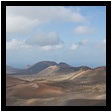



Foto gallery
Lanzarote 2007
During a holiday in 2007 I visited, with my family, the volcanic island Lanzarote and was impressed by it's nature and history.
Lanzarote is situated just 79 miles off the coast of Africa and is the most easterly of the Canary Islands. The island is 37 miles (60km) long and 12 miles (20 km) wide, making it the fourth largest island in the Canaries.
Lanzarote enjoys a mild dry climate with average daytime temperatures ranging from about 21°C in January to 29°C in August. Annual rainfall is just 140mm (5.5 inches). This makes Lanzarote the perfect year-round destination.
As with the other Canary Islands, Lanzarote is Volcanic in origin. Due to the recent eruptions during the 18th and 19th Centuries, many parts of Lanzarote appear to be from another world, often described as 'lunar' or 'Martian', so much so that parts of 'Planet of the Apes' were shot here.
The dry climate (and lack of erosion) means that the Volcanic Landscape appears much as it did just after the eruptions.
The island was created about 35 million years ago by the Canary hotspot. Alfred Wegener arrived in 1912 and studied the island and showed how it fitted in with his theory of continental drift. The island along with others was created after the breakup of the African and the American continental plates.
Amongst the many stunning Volcanic features of Lanzarote is the longest Volcanic Tunnel in the world, the Atlantida Tunnel, which is over 7 km long and includes the La Cueva de los Verdes and Jameos del Agua.
